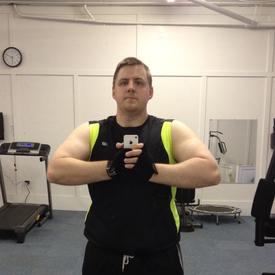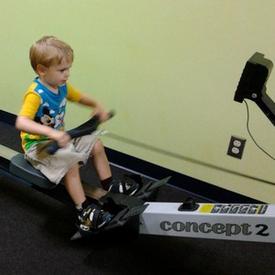Can you use HRM to calculate more accurate RMR?
Options

Mr_Knight
Posts: 9,532 Member
I'm just curious. If you hit "start" on your FT4 (or whatever) right before going to sleep, then sleep 8 hours, then hit "stop" and check the calorie burn...can you multiply that by 3 to get a "measured" value for RMR?
0
Replies
-
No.
The calorie estimation formula HRMs use are based on the known relationship between HR and VO2 max during moderate intensity steady state cardio activity. That relationship is almost nothing during sedentary or low intensity activity.
You wlll get an inflated calorie number0 -
No you'd be better off getting something like a Bodymedia for what you are requesting OP.0
-
If the relationship between HR and V02 doesn't hold while sedentary, why do overweight people almost invariably have higher heart rates than fit people, even when just sitting still?
Seems to me there should be some kind of quantifiable relationship, no?0 -
If the relationship between HR and V02 doesn't hold while sedentary, why do overweight people almost invariably have higher heart rates than fit people, even when just sitting still?
Seems to me there should be some kind of quantifiable relationship, no?
Perhaps I don't understand what you are saying. I don't see the relatinship between the two.
Overweight people can have higher heart rates than fit people but that doesn't have a relationship to VO2 max or calories burned. Oveweight people burn more calories at rest because their bodies require more calories to function. It also takes more energy to move higher weight.0 -
"The linear HR vs. VO2 relationship applies to moderate-intensity activity but is nearly a flat slope during low-intensity activity, resulting in a low correlation between HR and EE (Energy Expenditure) during sedentary and low-intensity activities. "
"If you want to read the studies those references are pointing to, Page 36 in the following study.
https://researchspace.auckland.ac.nz/bitstream/handle/2292/305/02whole.pdf?sequence=9 "
From Heybales post
http://www.myfitnesspal.com/topics/show/773451-is-my-hrm-giving-me-incorrect-calorie-burn0 -
To burn more energy requires more oxygen. I would imagine that is a major reason why heavier people generally have higher heart rates for the same fitness level. So there should be a useable correlation there.
Anyway, thanks for the replies. It doesn't cost anything to experiment, so I'll give it a go and see what happens. 0
0 -
This content has been removed.
-
you're using a device thats designed to measure cardiovasular energy system output, and are going to try and apply it to measuring fatty acid energy system output. You don't have to be a rocket surgeon to see why it's going to fail miserably. You're using it in a way that it simply does not work for.To burn more energy requires more oxygen. I would imagine that is a major reason why heavier people generally have higher heart rates for the same fitness level. So there should be a useable correlation there.
Anyway, thanks for the replies. It doesn't cost anything to experiment, so I'll give it a go and see what happens. 0
0 -
overweight people are generally lazy inactive people, so their VO2MAX is crap. thus their resting heartrate is also crap. thin people generally exercise to stay that way, thus have a VO2MAx thats not crap, thus a resting heart rate thats also not crap.If the relationship between HR and V02 doesn't hold while sedentary, why do overweight people almost invariably have higher heart rates than fit people, even when just sitting still?
Seems to me there should be some kind of quantifiable relationship, no?
Here's the kicker. Ask yourself why do overweight people who exercise almost invariably have a LOWER heart rate than normal weight people who do not exercise??? Cause this is true too.0 -
Here's the kicker. Ask yourself why do overweight people who exercise almost invariably have a LOWER heart rate than normal weight people who do not exercise??? Cause this is true too.
Hmmmm...you got me there, have to admit. Good point.
But I'm still going to try it anyway, just to see what comes out of it. 0
0 -
Here's the kicker. Ask yourself why do overweight people who exercise almost invariably have a LOWER heart rate than normal weight people who do not exercise??? Cause this is true too.
Hmmmm...you got me there, have to admit. Good point.
But I'm still going to try it anyway, just to see what comes out of it.
That's totally fine, but why ask in that case?0 -
To get an answer that made sense. Which is what I got, thanks to the good folks here.
 0
0 -
Any results yet?
Some of Polar's nicer HRM's that allow good setup with tested, calculated, known stats also may use RMR for HR's below 90.
90 is the HRFlex point for men and women, below which VO2 no longer applies to energy burn, and other means are better.
But if you assume 3.5 VO2max per kg / min (which is avg normal) at low HR up to whatever the formula says for 90, the slope may indeed be flat compared to 90-160, but it's something to use.
So curious what you ended up with.0
This discussion has been closed.
Categories
- All Categories
- 1.4M Health, Wellness and Goals
- 396.6K Introduce Yourself
- 44.2K Getting Started
- 260.8K Health and Weight Loss
- 176.3K Food and Nutrition
- 47.6K Recipes
- 232.8K Fitness and Exercise
- 449 Sleep, Mindfulness and Overall Wellness
- 6.5K Goal: Maintaining Weight
- 8.7K Goal: Gaining Weight and Body Building
- 153.3K Motivation and Support
- 8.3K Challenges
- 1.3K Debate Club
- 96.5K Chit-Chat
- 2.6K Fun and Games
- 4.5K MyFitnessPal Information
- 16 News and Announcements
- 18 MyFitnessPal Academy
- 1.4K Feature Suggestions and Ideas
- 3K MyFitnessPal Tech Support Questions



